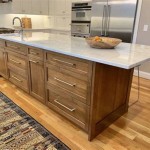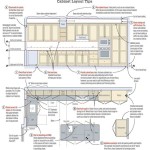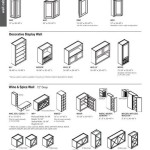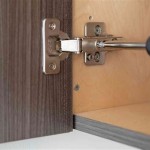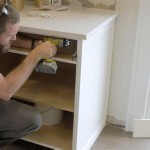Can You Paint Kitchen Cabinets Without Sanding?
Renovating a kitchen can be a daunting and expensive task. One of the most impactful changes can be repainting the kitchen cabinets. Traditionally, this involved a labor-intensive process of sanding, priming, and painting. However, advancements in paint technology have presented homeowners with a tempting alternative: painting kitchen cabinets without sanding.
This prospect is understandably appealing. Sanding is messy, time-consuming, and requires specific equipment. It also generates dust, which can be disruptive to the living space. The question remains, however, how effective and durable is this sanding-free approach? This article will explore the possibilities, benefits, drawbacks, and essential steps involved in painting kitchen cabinets without sanding.
Key Considerations Before Painting Without Sanding
* Cabinet Material: The success of a no-sand approach highly depends on the cabinet material. Laminate cabinets, for example, present a greater challenge for paint adhesion compared to solid wood. * Existing Finish: A glossy or varnished surface will likely require some level of surface preparation, even if traditional sanding is avoided. * Desired Finish: If a perfectly smooth, professional-grade finish is the goal, some sanding might still be necessary to achieve optimal results. * Time and Budget: While skipping sanding saves time initially, improper preparation can lead to peeling or chipping paint, necessitating costly repairs in the future.Suitable Paint Products for Sanding-Free Cabinet Painting
* Chalk Paint: Known for its excellent adhesion, chalk paint often requires minimal preparation and bonds well to various surfaces. * Mineral Paint: Similar to chalk paint, mineral paint offers good coverage and adheres well to many materials without extensive sanding. * Bonding Primers: These specialized primers are designed to create a strong bond between slick surfaces and paint, eliminating the need for sanding in some cases. * Cabinet-Specific Paints: Some manufacturers offer paints specifically formulated for kitchen cabinets that adhere well without sanding. These paints often have built-in primers and offer excellent durability.Steps for Painting Kitchen Cabinets Without Sanding
* Thorough Cleaning: This is the crucial first step. Use a strong degreaser, such as trisodium phosphate (TSP), to remove all grease, grime, and dirt. Rinse thoroughly and allow the cabinets to dry completely. * Deglossing: If the cabinets have a glossy finish, use a liquid deglosser or sanding sponge to dull the surface and improve paint adhesion. This step is crucial for a durable finish. * Applying Primer: While not always necessary, a bonding primer can significantly improve adhesion, especially on laminate or previously painted surfaces. Follow the manufacturer's instructions for application and drying time. * Painting: Apply thin, even coats of paint, allowing each coat to dry completely before applying the next. Multiple thin coats will provide better coverage and durability than one thick coat. * Sealing (Optional): A topcoat or sealant can provide additional protection against wear and tear, particularly in high-traffic kitchen environments.Advantages of Painting Cabinets Without Sanding
* Time Savings: Eliminating sanding significantly reduces the overall project time. * Reduced Mess: Sanding creates a substantial amount of dust, which requires extensive cleaning. A no-sand approach minimizes this mess. * Ease of Application: Skipping sanding makes the painting process easier and more accessible for DIY enthusiasts. * Cost-Effective: Less time and equipment translate to potential cost savings.Disadvantages of Painting Cabinets Without Sanding
* Potential for Imperfect Finish: Without sanding, imperfections in the original cabinet surface might still be visible. * Risk of Peeling or Chipping: If the surface isn't properly prepared, the paint may not adhere well and could peel or chip over time. * Limited to Certain Cabinet Materials: The no-sand method may not be suitable for all cabinet types, particularly those with slick or glossy surfaces. * May Require Specialized Products: Using appropriate primers and paints designed for no-sand applications can sometimes be more expensive than traditional paints.Assessing Your Cabinets for the No-Sand Method
* Inspect the Surface: Look for any existing damage, peeling paint, or imperfections. Minor imperfections can be addressed with wood filler. * Clean a Small Area: Test the cleaning process on a small, inconspicuous area to ensure the degreaser doesn't damage the cabinet finish. * Perform an Adhesion Test: Apply a small amount of primer to a test area and let it dry completely. Then, try to scratch it off with your fingernail. If it comes off easily, the surface likely requires further preparation.Important Tips for Success
* Cleanliness is Key: Thoroughly cleaning the cabinets is essential for paint adhesion. * Don't Rush the Process: Allow ample drying time between each coat of primer and paint. * Use Quality Products: Investing in high-quality primers and paints specifically designed for cabinets will yield better results. * Consider a Professional: If you are unsure about the no-sand method or have complex cabinet designs, consulting a professional painter might be a wise investment.
Can You Paint Kitchen Cabinets Without Sanding

How To Paint Kitchen Cabinets Without Sanding Sustain My Craft Habit

How To Paint Kitchen Cabinets Without Sanding The Budget Decorator

How To Paint Your Cabinets In A Weekend Without Sanding Them Chris Loves Julia

Diy How To Paint Cabinets Without Sanding Vlog

How To Paint Cabinets Without Sanding A Fresh Squeezed Life

How To Paint Kitchen Cabinets Without Sanding Or Priming

How To Paint Fake Wood Kitchen Cabinets Simple Made Pretty 2024

The Easy Way To Paint Kitchen Cabinets No Sanding Building Bluebird

How To Paint Cabinets Without Removing Doors House Mix
Related Posts

